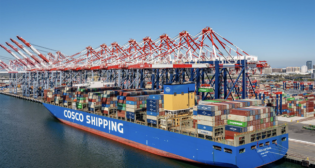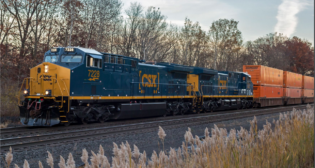
Safety-driven railway realignments
Written by David Thomas, Canadian Contributing EditorEach of these is a necessary incremental step toward risk mitigation, but even together, they are not enough to make hazmat trains “safe,” except to actuaries comfortable with pricing human lives in terms of insurance payouts. The “cost-benefit” test for safety reforms is unavoidably a callous calculation. It’s enough to give regulated capitalism a bad name.
The so-far modest responses to a year’s accumulation of exploding trains (four, plus a near-miss) shows that government and industry have heavy thumbs on the scale. The whines of DOT-111 owners notwithstanding, the solutions currently on the table are cheap in cost, and nearly weightless in benefit.
Let’s test the proffered solutions with some thought experiments applied to the circumstances that led to the derailment and chain of explosions that devastated the Quebec resort town of Lac-Mégantic, vaporizing 47 people last July 6.
Lab Test: Would changing the color of hazmat placards have reduced the explosive nature of the consist?
Lab Test: Would removal of propane and other volatiles avoid calamitous combustion in a 63-car pileup? Lab Test: Would hotbox detectors and track inspections suspend Newtonian physics as it applies to 60-mph runaway trains hitting a 10-mph curve? Lab Test: Could any tank car robust enough to resist breaching in a high-speed derailment be light enough to carry any oil at all?
Lab Test: Can Japan’s robot engineers provide humanoid train and track crews that will always perform to perfection?
So far, a locomotive engineer and two supervisors are the only people charged in a catastrophe whose causes reach deep into culture and governance. The scapegoats have been perp-walked; the anonymous culprits have returned to their spreadsheets.
True, if the locomotive engineer and train controllers had parked the train on the adjacent and derailer-protected siding, instead of a main line downgrade, the calamity at Lac-Mégantic would have been deferred to another time and place. But any safety regime that relies on human infallibility is delusional. Effective safety systems expect and anticipate human fallibility; they don’t make perfect behavior a critical dependency.
So far, the proposed solutions would mitigate, but not prevent, another tragedy on the scale of Lac-Mégantic, or worse. Are we willfully ignoring root causes and remedies simply because we have no faith that our contentious, free-market democracies are up to the level of national dreaming that gave us our transcontinental railroads in the first place, and that made our countries in the process?
Let’s look afresh at the death tolls of the four explosive derailments involving Bakken crude over the past 12 months: Lac-Mégantic, 47; Aliceville, Ala., 0; Casselton, N.Dak., 0; Plaster Rock, New Brunswick, 0. The common factors in all four are the derailments and explosions of DOT-111 tank cars carrying exceptionally volatile crude oil. The singular distinguishing difference among the four events is that the Aliceville, Casselton, and Plaster Point derailments, thankfully, just happened to occur out of range of human life.
The inescapable equation: Explosive derailment + proximity to human life = fatalities. The formula can be escaped only by eliminating one of the factors. So far, nearly all of the mooted solutions focus only on reducing the frequencies of derailments and explosions. Just one timid suggestion by the Federal Railroad Administration addresses the factor of human proximity.
The FRA’s plea that carriers try voluntarily to route oil trains away from population centers was noted by Transport Canada, yet dismissed as impractical for a linear country, laid out by Victorian-era railway builders. There are few alternative routes around Canadian cities and towns that grew like coral reefs around station stops.
The references by the FRA and its Canadian cousin to avoid population centers acknowledges the deepest cause of death-by-oil-train, but the meekness of their suggestions testifies to the perceived impossibility of doing anything about it.
The plain fact is that there is only one way to avoid destruction and death from hazmat mishap: Separate trains from people through a comprehensive realignment of the continent’s 19th century, intercity railroad map into a 21st century, high-speed freight network that bypasses urban populations.
Canada is the obvious place to start. The country’s towns and cities are enveloped by barely inhabited countryside of marginal economic or ecological value. High-speed, grade-separated urban bypasses, and digitally controlled classification yards and intermodal freight terminals could be built miles away from urban centers, with dedicated truck and pipeline connections to serve urban consignees. Buffer zones would protect rail corridors and terminals from residential and office development. Existing urban trackage would be dedicated to daytime commuter and intercity passenger trains, while maintaining after-hours way freight service for existing line side customers.
Canada’s railway network is at capacity. The national government is resorting to coercion to force the country’s Class I carriers to give rate-capped grain priority, even as it threatens to increase crude-by-rail if it doesn’t get its way with the Keystone XL pipeline. Other shippers, accurately or not, complain that oil train traffic is swallowing up track time and motive power that would otherwise move their commodities to port.
It’s not as though Canada has a highway network to handle the overflow. The so-called TransCanada Highway is a national shame, with much of it a homicidal two-lane road through the black fly-infested desolation of northern Ontario. (Most cross-country truck traffic still takes the same old shortcut across the northern U.S., once used by ox carts and stage coaches before the Canadian Pacific was built—expressly to defend British North America against the Manifest Destiny of American expansionists.)
The cost-benefit wonks will howl that it would be too expensive. That’s simply because Microsoft neglected to give Excel little boxes for human life and social good. Ascribing financial value to the loss of life, love, and happiness is just plain offensive.
Sure, we would have to devise a scheme for funding the relocation of transportation corridors (with room for highways and pipelines as well as trains) away from towns and cities. The U.S. Highway Trust Fund might be a model. Society has determined that moving hazardous materials by rail and road is necessary to our petroleum-based industrial and recreational economy, so that it makes sense that society as a whole share the cost. It is simply not ethically acceptable that the price for inaction be paid by randomly chosen men, women, and children who, by bad luck, happen to be within range of a hazmat catastrophe.
Disposition of some urban railway lands would contribute much of the cost. The rest could come from a fire-walled fund that would leverage some portion of national fuel taxes to finance construction. It doesn’t have to be done all at once. Cities and towns whose local governments feel the need to act could do so, in collaboration with senior governments, railroads, and property developers.
Fittingly, Lac-Mégantic is the first place where serious discussion about safety-driven railway realignment is taking place, led by the town’s mayor and council. The trains are running again through what was once the downtown core, but probably not indefinitely. Let us pray that the survivors of Lac-Mégantic may inspire a new age of railway building, national prosperity, and social well-being.



